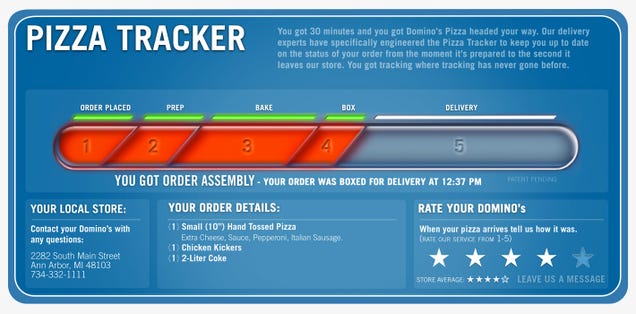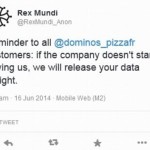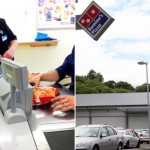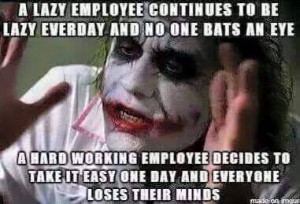Is the Domino’s Pizza Tracker Telling the Truth?

EXPAND
The tracker is legit—but only as legit as the people in the store let it be. The fact is, there are a lot of factors that happen in a store that the tracker can’t always account for, and so your mileage may vary with the online tracker for those reasons.
The Dream
As others have already mentioned, there’s a narrative to the tracker that the store supposedly follows: You place your order online. That order arrives at the store. The labels print out and are put on boxes. And the order itself appears on a screen at the make-line.
The person on the make-line assembles your food items and indicates that the order has been made. The tracker updates and tells you that your order is now in the oven. After a set period of time—somewhere around 7 minutes, give or take—the order should be out of the oven and in the process of being boxed. (Note: There is no button for employees to push to say that an order has come out of the oven; this is an automatically timed event on the tracker.)
Once your items are out of the oven and boxed, your delivery driver packs them in the hot-bag, gathers up any other items you may have ordered (sodas, sauces, chips, etc.), and “punches out” the order to say that, why yes, it is out for delivery. Once again, the tracker updates to let you know that your order is on its way.
Once the order is delivered and the driver returns, the driver signs back in to indicate that his run is complete. The tracker then updates for the final time—though, you should already know that the order’s been completed based on the pizza in your hands.
The Reality
Now, all that said, there are some factors that can affect your Tracker experience. Because delivery drivers can “game the system,” so to speak.
By Domino’s policies, for example, no driver is supposed to take more than two or three deliveries at a time (as memory serves). Corporate policy is very emphatic about that. Even though we don’t do the “30 minutes or it’s free” rule anymore, we do still strive to have every order delivered within 30 minutes or less to ensure customer satisfaction. Unfortunately, that 30 minute rule was only really made for stores with smaller delivery radii and enough drivers to consistently handle the amount of business received in a given day.
I worked at a store in Pittsburgh’s East Liberty neighborhood that delivered to roughly half the city of Pittsburgh—including every college campus, nearly every major hospital, the Strip District, and the Homewood/Lincoln-Larimer/East Hills neighborhoods. That’s a huge radius to cover, and even with an average of at least eight to 10 drivers per night, we didn’t have the ability to do our deliveries entirely by the book. Especially not if any given driver wanted to make a decent living that night. To compensate, most drivers would try to take between four and six deliveries at a time based, depending on the area to which they were delivering.
Under those circumstances, we usually aimed for about a 45 minutes delivery time. And that’s what we told people when they ordered—somewhere between 30-45 minutes for your order. People were usually perfectly happy with this—unless, of course, things took longer. But the tracker and the Pulse software used in-store aren’t set up to account for these individual store practices. Rather, they’re keyed into corporate standards.
In other words, each store is eventually evaluated on these widespread, not always applicable standards. Each order that’s placed has a timer attached to it tracking the time between when it’s placed and when it’s marked as completed. Those timers and statistics are then reported for store evaluations and taken into account, along with any and all customer feedback. These make a significant difference as to how a store is rated, how it’s treated, and essentially, how much a store is left to its own devices and allowed to keep doing what it does without supervisors breathing down the manager’s neck.
So stores will sometimes fudge numbers and cut corners so their stats look better. It doesn’t usually make any difference to the customer, who still gets warm pizza in a generally acceptable timeline, but it does make the store look like it’s running more efficiently than it really is.
The Tricks
Here are some of the things that happened in our store to make it look more efficient.
1) The order comes in and the make-line workers immediately mark it as completed and put in the oven. Since you can go back to look at the order after you’ve submitted it, this gave them a couple minutes time to get the order made and put in the oven, even though the tracker says it’s already in the oven. So shave two minutes there.
2) The order gets through the oven, boxed, and then put on the heat racks to be bagged and sent out. Meanwhile, on the computer for the drivers, there are five or six orders popping up on the screen with different addresses. It’s my turn to take the next delivery, so I see there are two right now that have been placed for a campus in Oakland – both are sitting at about 8 minutes on the timer, which means they’re ready to be punched out and delivered.
But just as I’m ready to punch those two deliveries out, there are another two for the sameneighborhood that just got placed. My choices are to let these other two orders sit on the timers for another 8 minutes (by which time they’ll be a nice red color on the screen, indicating that they’re very late) and then punch out all four deliveries for myself, or I can punch out the two orders now and use my “dummy account” (literally a ghost driver with a different name) to sign out the other two deliveries and take all four at once, delivering them in priority of time and convenience of route.
I use my dummy account to make the stats look better. Essentially, it means that the system shows us as having twice as many drivers working, while allowing us to take the deliveries we know we can make. Shady as hell when it comes to store evaluations, but for customer satisfaction, we didn’t have that many problems.
3) Now I’ve got my four deliveries punched out on both of my driver accounts, and I’m out the door to make my deliveries. My first two deliveries on my main account are finished, but I’m still making the deliveries on my dummy account, so I’m not going to be back in the amount of time that the system thinks that I should. That means, once again, that we have two options: A) We can let the timers say that the driver took a hell of long time to complete one delivery, or B) we let the timers reflect the general amount of time it takes to make the deliveries by having drivers/managers/make-line workers still in-store sign drivers in at around the time that theyshould be coming back from that delivery. Which one looks better for the store? You guessed it. Option B.
The Problem
Now this is where things have a tendency to get a little hinky with the Tracker. Because there are a couple things going on now that aren’t quite 100 percent true—but do show up a certain way on the Tracker.
The biggest problem is that because, say, Bob just got back from delivering orders and signed back in, any online order that he was delivering (as Bob) is now marked by the Tracker as having been delivered. But since Bob had five deliveries out and three of them were under his dummy account, Fred, Bob is still finishing his last two or three deliveries. So Bob may still has your order in his car (and, quite possibly, another one on his route to deliver before he gets to your house), despite the fact that the Tracker has so graciously informed you that your pizza has already been delivered.
We would get a decent number of calls from people informing us that the Tracker told them that their pizza had been delivered, but that they didn’t have anything on their table yet. You might get some people in-store and on the phones who tell you that the Tracker automatically does all that stuff, or that the driver should be there any minute and the Tracker just worked a little faster than your driver. But rest assured, unless your driver really messed up, your pizza did not get delivered to someone else. Or at the very least, if it did, the Tracker isn’t the way you’re going to find that out.
Sourced from gizmodo.com

























Recent Comments